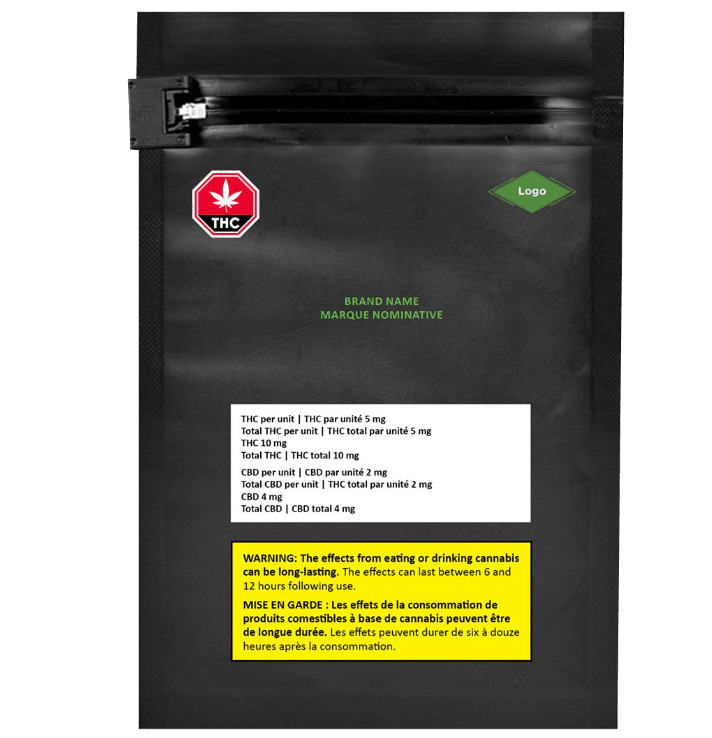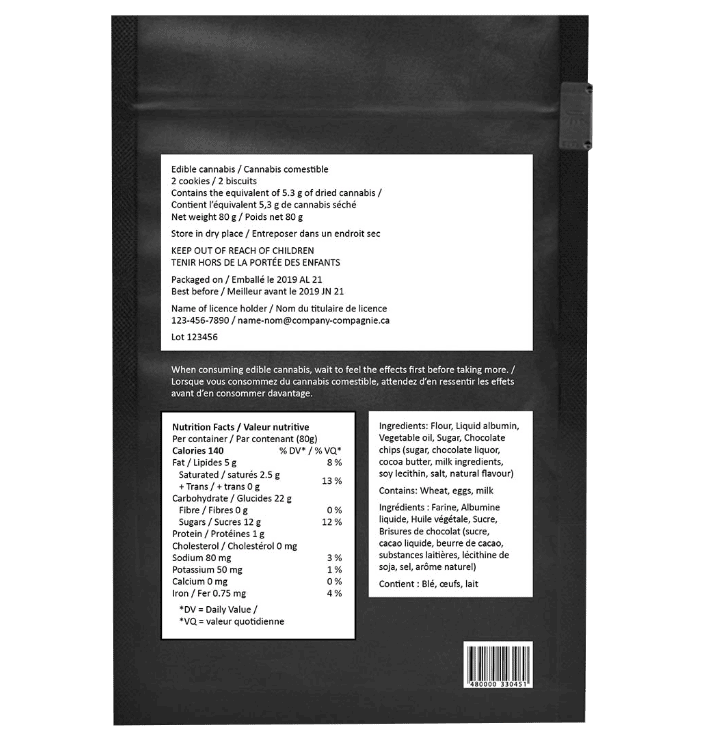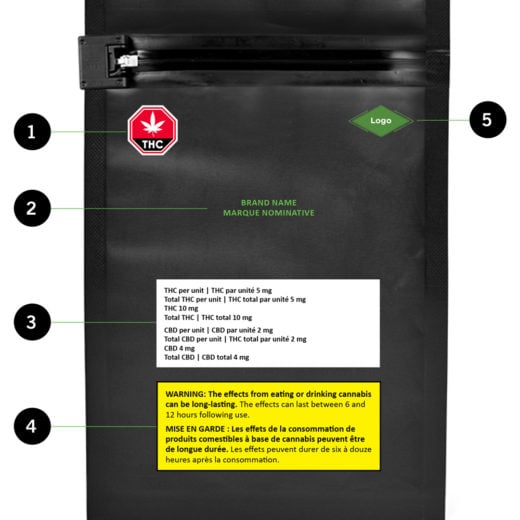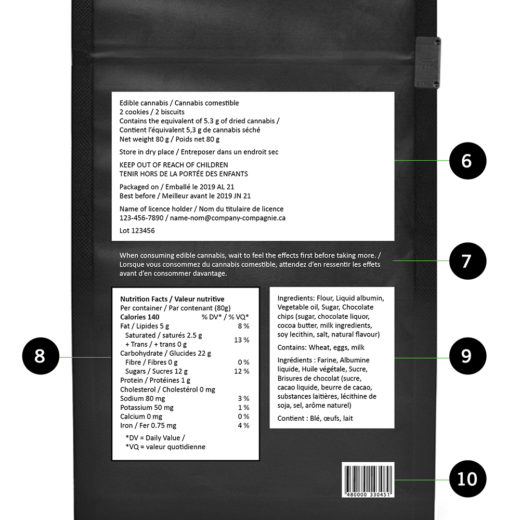Canadian Cannabis Labels
Source: Ottawa Public Health
Click or hover over each number to read the label’s description.
The descriptions for the numbers can be found below the images.




Understanding Methods of Consumption
Potency Limits on Cannabis Products in Canada
Always Read the Label.
Edible cannabis products vary in THC levels.
THC is the component of cannabis responsible for the psychoactive effects (the “high”).
New to edible cannabis? Start with no more than 2.5 mg of THC
Recycling Cannabis Packaging
Enjoy your greens while being GREEN!
Health Canada’s strict requirements for the information displayed on cannabis labels unfortunately results in the mandatory inclusion of bulky and excess packaging, regardless of the quantity of the product ordered. These requirements are important as they ensure that cannabis products are not appealing to children, are tamper-evident, provide necessary information to consumers, and prevent the product from being exposure to light and air. These specific requirements make it difficult to use biodegradable materials that can fulfill all the necessary criteria.
Cannabis products may be packaged in plastic jars, tubes, bags, or in glass. It may also come in cardboard boxes and have plastic wrappers. If your community has a curbside recycling program, they may accept most types of cannabis packaging; however, programs vary so please familiarize yourself with the restrictions and requirements.
What can not be collected by your local community recycling program may be eligible for recycling with the TerraCycle program. TerraCycle has partnered with Tweed and Tokyo Smoke to recycle cannabis packaging. See if there is a participating Tweed or Tokyo Smoke store near you.
Many other dispensaries have cannabis packaging and/or vape cartridge return programs so be sure to ask your local budtenders about it!
If you do not have access to a local participating dispensary and/or community recycling programs, here are some ways to reduce your cannabis waste:
- Buy in bulk if you can! One package of 28g of dried cannabis flower will come in less packaging than buying multiple smaller containers.
- Try making your own homemade edibles, oils and topical salves. Check out our Cannabinoid Dose Calculator to plan the potency of your products!
- If you prefer vaping cannabis, try using a dry herb vaporizer instead of disposable cartridges. There is some upfront cost with purchasing a vaporizer, but you can save money in the long run since dried flower is usually cheaper than buying cartridges and you can reuse the already-been-vaped bud for making edibles!
- Did you know you can add your joint butts, burnt flower from pipes and bongs, and your spent cannabis from infusing edibles into your compost pile or green bin?
Canada. (2019). Packaging and labelling guide for cannabis products: Requirements under the Cannabis Act and the Cannabis Regulations. Government of Canada = Gouvernement du Canada. https://www.deslibris.ca/ID/10102214
Cannabis Laws in Your Province or Territory:
Provincial and Territorial governments are able to modify their sales models, age limits, and rules on possession amounts and growing for personal use. In private sales models, the government issues licenses to allow for licensed private businesses to sell cannabis.
In public sales models, only the government stores allow sales of cannabis.
Hybrid models have both government and licensed private businesses selling cannabis. In all provinces, except for Saskatchewan and Manitoba, the government store websites are the only way to buy legal cannabis products online.
Depending on which province or territory you are in, there may be different laws around growing for personal use or using in public.
The limit for personal growing is 4 plants. If you need to grow more due to medical use, you must apply for a license through a cannabis clinic. In Quebec, Nunavut, and Manitoba, you are not allowed to grow cannabis yourself.
The provinces shown in green have restrictions on use to be allowed only on private property and the ones in orange mean that you are limited to similar rules as tobacco for public use.
The minimum age for sale and possession of cannabis is 19 years old, except in Quebec it is 21 and in Alberta it is 18 years old.
Cannabis Laws in Each Province or Territory
| Legal Age | Grow at Home | Shop Online | Shop in Person | Use in Public | |
|---|---|---|---|---|---|
| NL | 19 | 4 plants allowed | Only from ShopCannabisNL.com | Only from licensed retailers, go to ShopCannabisNL.com for a list | No, private property only |
| NB | 19 | 4 plants allowed | Only from Cannabis-NB.com | Only from Cannabis NB stores, go to Cannabis-NB.com for a list | No, private property only |
| NS | 19 | 4 plants allowed | Only from Cannabis.myNSLC.com | Only from NSLC stores, go to Cannabis.myNSLC.com for a list | No, private property only |
| PE | 19 | 4 plants allowed | Only from PEIcannabiscorp.com | Only from PEI Cannabis Corp stores, go to PEIcannabiscorp.com for a list | No, private property only |
| QC | 21 | No | Only from SQDC.ca | Only from SQDC stores, go to SQDC.ca for a list | No, private property only |
| ON | 19 | 4 plants allowed | Only from OCS.ca | Only from licensed retailers, go to AGCO.ca or OCS.ca for a list | Same as tobacco |
| MB | 19 | No | Only from licensed retailers websites, go to LGCAMB.ca for a list | Only from licensed retailers, go to LGCAMB.ca for a list | No, private property only |
| SK | 19 | 4 plants allowed | Only from licensed retailers websites, go to SLGA.com for a list. | Only from licensed retailers, go to SLGA.com for a list | No, private property only |
| AB | 18 | 4 plants allowed | Only from AlbertaCannabis.org | Only from licensed retailers, go to AGLC.ca for a list | Same as tobacco |
| BC | 19 | 4 plants allowed | Only from BCCannabisStores.com | Only from licensed retailers, go to Justice.Gov.BC.ca for a list | Same as tobacco |
| YT | 19 | 4 plants allowed | Only from CannabisYukon.org | Only from licensed retailers, go to CannabisYukon.org for a list | No, private property only |
| NT | 19 | 4 plants allowed | Only from NTLCC-Cannabis.ca | Only from licensed retailers, go to NTLCC-Cannabis.ca for a list | Same as tobacco |
| NU | 19 | No | Only from licensed agents of NULC: Tweed.com/en/shop/nu or VerticalCannabis.ca | No | Same as tobacco |
Cannabis Laws in Each Province or Territory
Legal Age: 19
Grow at home: 4 plants allowed
Shop Online: Only from ShopCannabisNL.com
Shop in Person: Only from licensed retailers, go to ShopCannabisNL.com for a list
Use in Public: No, private property only
Legal Age: 19
Grow at home: 4 plants allowed
Shop Online: Only from Cannabis-NB.com
Shop in Person: Only from Cannabis NB stores, go to Cannabis-NB.com for a list
Use in Public: No, private property only
Legal Age: 19
Grow at home: 4 plants allowed
Shop Online: Only from Cannabis.myNSLC.com
Shop in Person: Only from NSLC stores, go to Cannabis.myNSLC.com for a list
Use in Public: No, private property only
Legal Age: 19
Grow at home: 4 plants allowed
Shop Online: Only from PEIcannabiscorp.com
Shop in Person:Only from PEI Cannabis Corp stores, go to PEIcannabiscorp.com for a list
Use in Public: No, private property only
Legal Age: 18
Grow at home: 4 plants allowed
Shop Online: Only from AlbertaCannabis.org
Shop in Person:Only from licensed retailers, go to AGLC.ca for a list
Use in Public: Same as tobacco
Legal Age: 19
Grow at home: 4 plants allowed
Shop Online: Only from BCCannabisStores.com
Shop in Person: Only from licensed retailers, go to Justice.Gov.BC.ca for a list
Use in Public: Same as tobacco
Legal Age: 19
Grow at home: 4 plants allowed
Shop Online: Only from CannabisYukon.org
Shop in Person: Only from licensed retailers, go to CannabisYukon.org for a list
Use in Public: No, private property only
Legal Age: 19
Grow at home: 4 plants allowed
Shop Online: Only from NTLCC-Cannabis.ca
Shop in Person: Only from licensed retailers, go to NTLCC-Cannabis.ca for a list
Use in Public: Same as tobacco
Legal Age: 19
Grow at home: No
Shop Online: Only from licensed agents of NULC: Tweed.com/en/shop/nu or VerticalCannabis.ca
Shop in Person: No
Use in Public: Same as tobacco
Cannabis and Driving Laws
When you drive a vehicle, you need to be alert and focused. Consuming even small amounts of cannabis affects your ability to react and increases your chance of being in a crash.1 Cannabis can impair your ability to drive by:
- affecting motor skills;
- slowing reaction time;
- impairing short term memory and concentration;
- causing drivers to vary speed and to wander; and
- reducing the ability to make decisions quickly or handle unexpected events1
These effects are multiplied when using a combination of cannabis, alcohol, and/or other drugs.2
Mothers Against Drunk Driving (MADD) Canada’s research has shown a growing incidence of driving after drug use. The number of deaths involving drugs alone is double those involving alcohol alone.3 Cannabis, the most commonly found drug, is present in almost half of the drug-positive fatal crashes.3 It must be emphasized that the figures document the presence of alcohol and/or drugs and not whether the individual was legally impaired. While research indicates that most of the alcohol-positive individuals were likely impaired or very impaired, there is no comparable information on the drug-positive drivers.3 However, it should be noted that the drug tests are designed to detect the recent use of psychoactive drugs that adversely affect driving skills, rather than metabolites that merely indicate use of the drug sometime in the past.3
Police need a reason to stop you and you have the right to know why. If you are legally stopped by the police, they may check for bloodshot eyes, breath or body odour, balance, temperature, and pulse. If they suspect that you are impaired with drugs or alcohol, they can test your saliva, breath, urine or blood.
You cannot contact a lawyer before a roadside test. Refusing a roadside test is a criminal offence.
If you question the result of the first test, you can ask for a second test on a different screening device. However, be aware that the next reading may be higher as your body absorbs alcohol or drugs. Police will use the higher reading.
There are three prohibited blood levels of THC (the active component of cannabis that causes a “high” and the associated physical effects) while driving:
- 2 nanograms (ng) but less than 5 ng of THC per millilitre (ml) of blood
- 5ng or more THC per ml of blood.
- When there is a combination of cannabis and alcohol, the prohibited levels are 50mg (milligram) or more of alcohol per 100ml blood and 2.5ng or more of THC per ml of blood.
| 1st offence | 2nd offence | 3rd offence | Over 2ng but less than 5ng of THC per mL of blood within 2 hours of driving |
|---|---|---|---|
| mandatory minimum: $1000 fine | mandatory minimum: 30 days imprisonment | mandatory minimum: 120 days imprisonment | maximum $1000 fine |
| maximum: 10 years imprisonment | maximum: 10 years imprisonment | maximum: 10 years imprisonment | It is a more serious offence to have 5 ng of THC or more per ml of blood. |
Penalties for THC-Impaired Driving
Cannabis can affect each person differently. The impairment on individuals can depend on:
- The method of consumption, for example how cannabis was ads consumed (smoked, inhaled, ingested);
- The quantity of cannabis consumed;
- The person’s current cannabis tolerance;
- The person’s individual metabolic and biological factors;
- The variety of cannabis and its THC levels, including cannabis prescribed for medical use. The two main cannabinoids in cannabis products, THC and CBD, have different effects. THC is considered the “impairing” cannabinoid and CBD does not generally produce a “high”, although again it will depend on the above factors. Visit our section on cannabinoids!
As a result, there is no guidance to drivers about exactly how much cannabis can be consumed before it is unsafe to drive or exactly how long a driver should wait to drive after consuming cannabis. However, based on the available evidence, The Centre for Addiction and Mental Health (CAMH) recommends waiting at least 6 hours after consuming cannabis for recreational purposes before you drive. There are a number of situations and scenarios that would require a longer wait time.
The following recommendations are based on preliminary evidence and advice from the Ontario Medical Association. They suggest that people who are consuming cannabis for medical purposes refrain from driving for:
- 4 hours after inhalation (smoking or vaping in any form)
- 6 hours after oral ingestion (oils, capsules, edibles)
- 8 hours or more after inhalation or oral ingestion if they experiences a psychoactive high
The wait times above are largely based on a review that differentiates the medical cannabis user from people who use recreationally. Someone who is prescribed cannabis for medical purposes is typically instructed to consume individualized doses of cannabis to achieve symptom relief rather than to achieve a subjective high.
1.) Canada, P. S. (2017, February 7). Drug-impaired driving [Policies]. https://www.canada.ca/en/services/policing/police/community-safety-policing/impaired-driving/drug-impaired-driving.html
2.) Fischer, B., Russell, C., Sabioni, P., van den Brink, W., Le Foll, B., Hall, W., Rehm, J., & Room, R. (2017). Lower-Risk Cannabis Use Guidelines: A Comprehensive Update of Evidence and Recommendations. American Journal of Public Health, 107(8), e1–e12. https://doi.org/10.2105/AJPH.2017.303818
3.) Cannabis and Driving. (n.d.). MADD Canada. Retrieved 23 June 2021, from https://madd.ca/pages/impaired-driving/overview/cannabis-and-driving/
Government of Canada, D. of J. (2018, June 22). Impaired Driving Laws. https://www.justice.gc.ca/eng/cj-jp/sidl-rlcfa/
Neavyn, M. J., Blohm, E., Babu, K. M., & Bird, S. B. (2014). Medical Marijuana and Driving: A Review. Journal of Medical Toxicology, 10(3), 269–279. https://doi.org/10.1007/s13181-014-0393-4
Cannabis and Driving. (2019). Ontario Medical Association. https://content.oma.org/wp-content/wp-private.php?filename=V4-10-2019-Cannabis-and-Driving.pdf